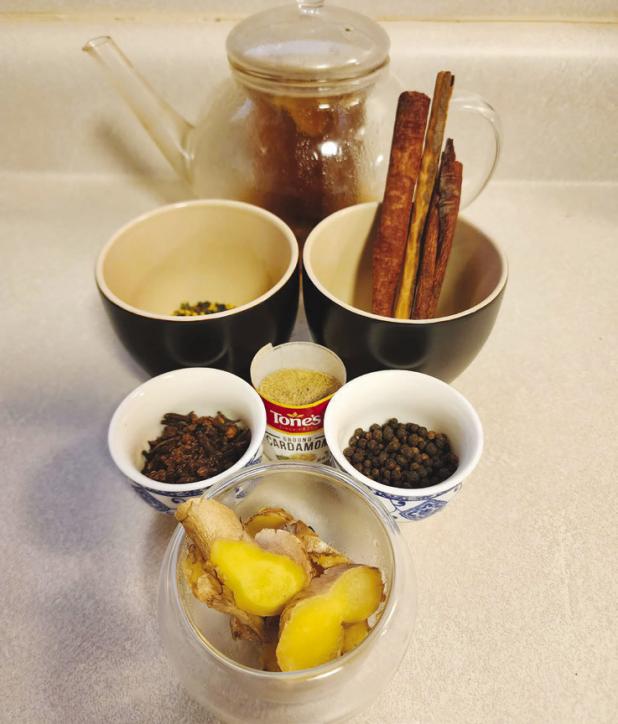

TASTE of Olney
This week, I wanted to showcase a recipe that brought me a lot of comfort during the up-and -down temperatures of the past few weeks and helped me avoid the maladies that were going around – my friend Mona Bernhardt’s chai recipe. She served it to me while we were working on mental health committee business this spring, and I fell in love with its peppery, gingery, creamy warmth. Then I learned that she had made the tea herself and begged for the recipe.
“Chai besides being super yummy has many health benefits. The main ingredient, ginger, benefits 3 systems: digestion, immune as well as the well as the nervous system. This recipe includes black pepper, which gives this chai a nice bite, and is another ingredient that’s good for the nervous system,” Mona said.
Chai, also known as masala chai, is a spiced tea beverage that has a rich and complex history dating back thousands of years. Originating in India, chai has become a beloved drink around the world, known for its warm, comforting taste and its ability to bring people together.
The word “chai” actually means “tea” in Hindi, and the drink itself is a blend of black tea, spices, milk, and sweetener. Traditional spices used in chai include cardamom, cinnamon, ginger, and cloves, although the recipe can vary depending on the region or personal preference.
The use of chai as a beverage dates back to ancient times in India, where it was believed to have medicinal properties and was used as a digestive aid. It was also a popular drink among the ruling classes and was served in silver or gold cups as a symbol of wealth and status.
As chai spread throughout India and eventually to other parts of the world, its popularity grew, and variations of the recipe began to emerge. In the 1900s, the British began adding milk and sugar to their chai, creating what is now known as “chai latte.” Today, chai can be found in many forms, from traditional recipes made at home to pre-packaged tea bags and even bottled drinks.
Beyond its delicious taste, chai has also become a cultural symbol, representing hospitality and community in many parts of the world. In India, it is often served to guests as a gesture of welcome, while in the United States and other western countries, it has become a popular beverage for socializing and relaxing.
In recent years, chai has also gained attention for its potential health benefits. Many of the spices used in chai, such as cinnamon and ginger, have anti-inflammatory properties and may help boost the immune system. Black tea, which is the base of chai, contains antioxidants and has been linked to a reduced risk of heart disease and stroke.
Overall, chai tea has a rich and fascinating history that spans thousands of years and multiple cultures. Whether enjoyed as a comforting beverage at home or as a cultural symbol among friends, chai remains a beloved and timeless drink. Adapted, with alterations, from Sangeet Khalsa’s Yogi Tea recipe, www. healingsource.com/sangeets-blog/239ahh-haa-the-secret-aroma-was-calledyogi- tea.
This recipe creates a rich concentrate that can be stored indefinitely in the refrigerator (without any milks or sweeteners). Ingredients:
1-3⁄4 Tbsp black peppercorns 1 tsp whole cloves 7-9 Tbsp cardamom seeds (not pods) 7 sticks cinnamon 2 cups sliced ginger root About 6 quarts water Preparation: Step 1: Boil all ingredients in water for 1-½ hours, turning the heat down once boil is reached to just enough to keep a slow roll going. Turn the flame off and allow to soak for 2 hours.
Step 2: Add 2 bags of any black tea (recommend oolong) for the last 15 minutes. Option: Allow to soak overnight including black tea.
Step 3: Strain into containers. Freezable. If freezing, use plastic container and leave enough room for expansion of liquid to ice.
Step 4: To serve, add milk and sweetener to taste. May serve either hot or cold, excellent as a frappe.
